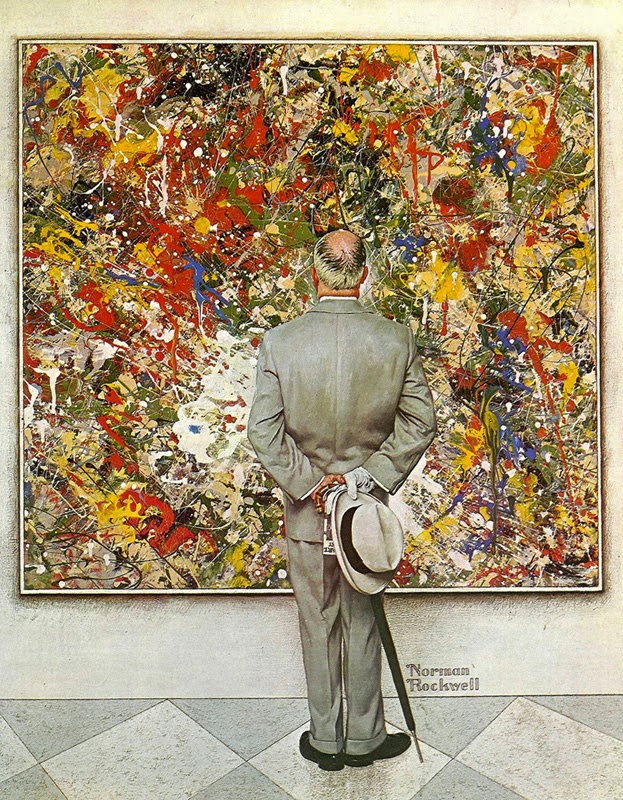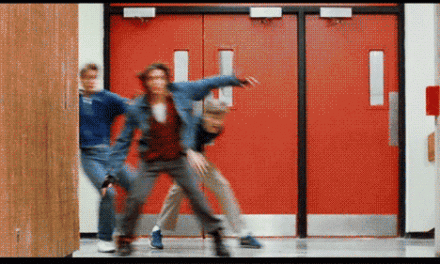 |
| The Connoiseur, by Norman Rockwell |
David Palumbo
After reading Lauren’s recent post regarding online criticism, I found myself thinking quite a bit about the broad subject of taste. Beyond art, we all tend to have a quality standard for anything which we are even marginally interested in. The good, the bad, the forgettable. Whether music, movies, books, clothes, or even just the best places to get a taco, I believe that we all have a personal dividing line somewhere in that mediocre middle where a things is just plain bad. Where it has failed at being whatever that thing could have gloriously been, and especially when it has failed to a spectacular degree. I don’t know if I’m so cynical to believe that most people enjoy witnessing failure (anyone who has ever watched a live performance tip just a bit off the rails knows the feeling of an audience collectively holding their breath and hoping that the performer can pull it back) but, to put it charitably, it certainly seems that people enjoy demonstrating their intelligence and good taste by pointing out where they feel efforts have failed. I saw a photo series online just this morning which had an interesting premise and then, in my opinion, severely botched execution. Half-assed concepts woven with bad technique. I REALLY wanted to point my finger and say “that was 100% terrible!”
I didn’t, but I wanted to. Instead I read the comments of other people who did it for me. This only furthered my frustration though as, despite largely sharing my opinion that it was bad, they felt it was bad for all of the wrong reasons! It was like seeing a movie you were really excited for but then it had massive plot holes which distracted from the story and a horrible third act which didn’t make any sense at all and afterwards your friend turns to you as says “that was an awful movie! There were almost no musical numbers at all!” This is the realization that not everyone is looking for the same satisfaction.
I think most artists of any stripe come to understand that you really can not please all the people all the time. Some of us can accept this, some will understand it but struggle with the reality of it, and some will struggle to even acknowledge it by continuing to try to please everyone. But they can’t of course, no one can, because we don’t all want the same thing.
The rare things which are generally agreed to be the greatest are always compromises in my opinion. Not that they were executed as compromises, but their “best of” title represents a compromise of varied opinions. I don’t think the Mona Lisa is the “best” painting in the history of art and I don’t think that either Pat’s OR Genos have the “best” cheesesteak in Philly. I also don’t think those are controversial opinions to share because, despite often being cited as such, most people who actually have considered, thought out opinions on either topic will probably agree with me. But that is the nature of mass-audience favorites: sifted crowd-pleasers which are known, acceptable, and non-offensive. The “best” song by the “best” band could easily be something along the lines of Hey Jude by the Beatles. Yes, it’s a good song, a pretty great song, but I’d wager it probably isn’t your (speaking to you!) favorite (all time everything) song. I am certain that it actually is the favorite song of very many people, but odds are that it isn’t yours. Whatever your favorite song is, it probably has something about it which many people would dislike if they even know it at all and some people would even find a reason to dislike it that had nothing to do with what it even sounds like.
And the nice thing is, everyone is right. We’re all right because we all get to like things and dislike things for our own highly personal and highly irrational reasons. It’s not about logic, it’s about love.
Oh, but when other people like something we don’t like, that can be obnoxious. How can people be so stupid to actually like that junk! Or maybe they’re pretending to like it so everyone will think they’re smart but obviously nobody really likes it! These are injustices that demand sharing online! Of course, you can’t really convince someone by arguement they don’t like a thing anymore than they can convince you that you actually do (you don’t). Never the less, we all too often feel compelled to try. Or at the least to make it known that we’re not like those fools liking all that idiotic mess. We have standards.
As a human, I struggle with these things. As an artist, I am sensitive to the fact that most creative work is the result of an honest effort and I respect courage and labor. As your average asshole with an opinion, I know that my opinion is the best one.
To be serious though, this does have a point. My opinions on certain subjects can be very strong and, no surprise, visual art is among them. I know what I like and I know what I don’t. For many years, that was all I needed. I would be frustrated by the success of peers who clearly did not deserve it or by schools of painting which were transparently unapologetically bullshit (ok, I might still twinge a bit on that one) and lament that others of promise were overlooked. Even leaving out the larger Art World, I felt the same irritation in the broad spectrum of illustration. I remember my first time seeing an annual exhibition at the Society of Illustrators which, at a time at least, was generally perceived as, well, not overly enthusiastic on the whole “fantasy art” scene. “Half these guys can’t even draw!” was probably a fair approximation of my open-minded verdict. And so my opinions went until, a few years later, I took a position as an art director for an indie publishing company.
My perception did open up a bit right away as I began matching artists to upcoming projects. Initially I had imagined that I would try and just hire my favorite painters as often as I could get away with, but I realized pretty soon that they often were not really right for whatever the next title on the list was. The true lesson did not really land for a few months though.
I won’t name names here, those involved will know, but I had a cover on the schedule which seemed to me an ideal fit for an artist who’s work I greatly admire. On top of this, I was able to get the jacket design to be handled by a designer who I think is positively brilliant. We didn’t have much budget so this was pretty exciting, particularly being that both were my first best choices for the job. The author’s previous books (of a different publisher) had what I would only describe as a consistently dull, uninspired, generic look. There was an exception that I found which was pretty good but was later told that the author had never much liked that cover. But that is post script. At the time of commissioning, I was excited to do something much more visually exciting, interesting, and dynamic which was also a perfect indication of the tone of the story. No big type and stock photos, but a beautifully painted and designed cover with The Right People hired on to see it through. When the work came in it was, in my opinion, everything that I’d hoped and expected. Because I was working from Philly and the publisher was in San Francisco, our communication was all phone calls and emails but the editors seemed pleased and it was job well done. Then, a bit down the road, the image released online that the authors fans began to comment. The fans were not happy. As more and more comments accumulated, the tone grew progressively more blunt and then progressively more offensive. Of course I stayed out of the discussion, but I read every single post. I had a handful of tiny victories as an occasional reader would voice their approval, but overall it was very very bad. At first I was annoyed and then I began to get really angry because the comments were getting rude and half of them didn’t even come close to describing what the cover actually looked like. I hope with all of my heart that the artist never saw them (though I know the designer did). Ridiculous critiques were given on technique, unfavorable comparisons were made to other artwork and styles which bore absolutely no resemblance, and in general it felt like they were all insane, small minded trolls. And then I read one comment which made me completely re-evaluate how I have looked at commercially oriented creative work ever since. This is not a direct quote, but it was along the lines of:
“I would be embarrassed to be seen reading this”
And first of all, fuck you. But second of all, ohhhhhhhhhhh. The clouds parted and I really, deep down in me, understood the importance of all of the different disciplines of illustration. All the many flavors. Those boring covers in this author’s back catalog were the sort of covers that the bulk (or at least the vocal contingent) of the authors readers really enjoyed and felt comfortable with. I would never in my life have wanted to art direct a cover like those until I understood the purpose which it served. It wasn’t lazy. It wasn’t because of budget constraints. It wasn’t even because the publisher had no interest in art. It was because the people they were marketing to liked it. They saw something in it which they genuinely responded to and that helped them buy those books.
After this, I began understanding all kinds of illustration styles which I’d previously written off (mostly anything that wasn’t painted realism) and, even more than that, beginning to see their value in the industry. I was beginning to see their quality as artistic expression. In some cases, I was even beginning to see their genius. Art is not Good because it took 200 hours to execute. Art is Good because it makes a connection with its audience. And if people are connecting to art and you think it sucks, the odds are pretty good that it just was not created for you. Get over yourself.
There are still many schools of painting which I have difficulty connecting to. When I visit museums, I know where I will spend most of my time and where I will likely skip when my feet get tired. I’m ok with that because it is unreasonable for a person to genuinely enjoy everything. I do my best to understand and not to dismiss, I look for the entry point so that I can find my own connection if it exists, but I save my enthusiasm for the work that I am passionately head over heels for. It is a mistake to confuse taste with quality. The world doesn’t need more small minded haters, it needs enthusiasts who can accept that the whole of art was not created for their benefit. So the next time we feel the urge to point out how something popular is really just crap, we should have a discussion and try to learn something instead. Or, failing that, do something useful with our energy like enjoying and supporting the work that we love and leaving others to theirs.






Really nice, well thought out post Dave. I love when we have epiphanies, both large and small, and then recognize and act on them. Thanks for the work you put into this. Great stuff.
Thanks Bill! Your work was among that which helped bring me out of my uptight cocoon and see how much great stuff I'd been missing out there
Your story about the cover: YES. THIS. EXACTLY. Oh man, if only I could just hire whoever I wanted… But target audience is a bitch.
I really enjoyed reading this Dave. We are much better, well rounded artists when we keep our minds open to epiphanies like this.
This really hit home with me and I can appreciate the sentiment. I also understand and appreciate that everyone has different sensibilities – particularly when it comes to the visual arts. All that said, I guess I am still small minded. I can appreciate the underlying reasons why something might be selected by an art director or a judge at a juried show, but I still don't always agree with it. Particularly when the art really is “crap”, as in really and truly my 3 year old could have done that – and not because I have a child prodigy. So for me, I would never publicly voice what I feel, but on the other hand I refuse to give in to some of the cultural art bias that we are told to swallow just because a critic in New York told us to.
I can also understand, by the way, that sometimes different styles are selected purposefully to reach a specific audience as in a fan base. However, I don't think those criteria should be applied across the board to art. The book covers you mention were “mediocre” as pieces of art whether the fans loved them or not. So there are two parts to this – 1) is something technically/artistically good (as in the cover you had produced) and 2) what is needed to fulfill a certain marketing purpose (the mediocre covers) – I don't believe they have to be meshed into one concept to both be valid.
To the first point, I think it is really just about having respect for the opinions of others and I agree that can sometimes be *very* difficult. On both sides of the spectrum. I certainly sympathize with people who lament about modern blockbuster movies being all flash and no substance, but clearly there are huge numbers of people who don't demand more than this, and whether I like that or not is irrelevant. I just accept. On the other side, there are entire art museums that I am unlikely to ever revisit because I just did not see anything interesting or inspiring in their collections, some to the point of being offensive to me, but again I have to accept that some people love art for exactly that type of work.
Particularly the topic of “crap” art, I do get annoyed when the statement is more important than the art itself. Some artists seem to have perfected the craft of marketing to the point that their actual work is irrelevant and it seems like a massive con. And, for some people, that is what they dig about it. People have told me this when I asked “but why?” But I also feel much of that work is made with legitimate creative intentions but just not ones that I relate to. Some people aren't so interested in draftsmanship or nuances in values, or realist visual aspects. The visual aspects are just the conduit to the larger story or idea which they connect with. You can't win if we aren't all even playing the same game. It makes me think of the recent Banksy stunt of selling his work anonymously in central park with fairly dismal results. When the truth was revealed, people suddenly wanted it and it had obviously nothing to do with the visual objects. It had to do with other more abstract things which, for some people, are the most interesting part of art.
On a more cynical note, I definitely don't think we have to find it in our hearts to like things just because other people do, unless that elitist mentality is what drives you in appreciating art. There is no doubt that for some people it is, particularly really rich people who use art as measures of status, and I can't relate but I will accept. But I also believe that there are people who genuinely do enjoy that same work on an emotional level.
I think it is ok to voice opinions along these lines if it is motivated by discussion and understanding. Probing and questioning is a good thing. The problem is when it turns to shaming or ridicule of another person's opinions. I do my best to avoid going there but I surely don't always succeed.
On your final point, this seems to me to presume that there is such a good thing as “right” art and “wrong” art. That work was mediocre to me just as I find some very celebrated periods of art history mediocre, but that doesn't mean that I'm correct is being so dismissive. I'm correct for me on a personal level, but not correct in a global sense. It is possible that they were actually brilliant but I do/did not have the eyes to see it. Maybe a year from now I will look at one of them and find all kinds of things to fall in love with. I've had opinions flip like a switch in both music and visual art and never with any reasoned argument, but just because I suddenly experienced it in a meaningful way. About those mediocre covers, I certainly know enough to recognize really bad designs of the same style when I see them, it is just hard for me to figure why. Which is one reason I'm not a great graphic designer.
Applying this to across the board art, however, I see no difference. An artist is communicating with people through their work but not everyone will speak the correct language. If I don't understand the language, it is not my place to judge the quality of their message. I agree that technical proficiency and communication of idea (which I think its another way of saying marketing goals) do not need to be of equal level for art to succeed because not all audiences demand both or value them equally.
People either seem to love my work or hate it. I like that. Either way there was a reaction, and even if they didn't like it, they might not forget it. It's still communicating, and it's always interesting to see who goes where.
I love this site 🙂
Does anyone else notice the capital P in red in the Pollack painting? Can't be an accident! P for Pollack!
Insightful and succinctly written! Thank you.
First of all, excuse me for my poor English
It agree with you that we must have an open mind and respect the work of any artist but unfortunately in the globalized world we live sells more provocation that the message you want to communicate and art was not to be outdone, is a reflection of society. Anything goes even if it is empty of content.
An example is the piece “A thousand years” the most quoted living artist: Damien Hirst.
( A large urn rectangular glass divided into two communicating rooms between them. On the right, a white block hides a fly larvae. On the left, a cow's head donates his blood to feed newly hatched flies and already destined to die attracted by an anti-mosquito lamp hanging just above ).
I can respect your idea, the concept (showing a closed life cycle depicting the birth, life and death) but not the way he communicated, that to me is not art, it's show.
If any of us we we put a brush in the ass and up the creation of our works in youtube, sure we had Mr. Charles Saatchi knocking on the door ( oops! there is someone that does something similar, writing Pricasso in google, seeing is believing! ).
Greetings from Spain
Cheers a good deal for that a la mode(p) educators day time Estimates. Let me contain it during my educator’second day talk. For additional lecturers time is quoting you toilet look into the land site.
happy teachers day
So far as I understand, my response to this is that I agree in not finding anything meaningful or interesting about this work, but I accept and respect that those who do find meaning are not wrong, but valuing different virtues. It is very difficult for me to defend Damian Hirst, but that is largely because my goals and ideals are largely of no interest to him or his fans and vice versa.
Perhaps this is a sad reflection of society, but to say so is still based on abstract and relative ideals and I am in no position to declare it. Others could just as easily hold a firm belief that the artwork which I enjoy is empty, pointless, or otherwise lacking and they could list their reasons. In the end, nobody is right and nobody is swayed.
I enjoyed you post very much. I used to think the same about the field of art or illustration (and other fields). My frustration really started to grew in art academy, when I got confronted with some artists and their works which on one hand just didn't fit my taste and on the other hand they even pretended that it was bigger, better or whatever else they thought it was. Some just created something and made up a story afterwards which was not even as frustrating as the ones which were just plainly re-creating (stealing) illustrations/art made by others.
Over time I learned to cope with them. Sometimes you never heard from them again, sometimes they ended up creating their own ideas finally and me liking their art.
But I had an illuminative moment when I taking part in a exhibition. First I was walking through the exhibition room when I saw three people having a discussion over one of my illustrations. Curious as I was I walked up to them but soon slowed down when I noticed they were not very positive in their comments. Basically they just didn't like it for no reason (at least they didn't say what they disliked about it). I didn't bring up the courage to ask them why they don't like it… Maybe a good thing, but sometimes it makes me curious what the answer would have been. About 45 minutes later I was examining a piece by another illustrator talking to a friend, analyzing what I would have done differently. Embarrassingly enough the illustrator just did the same thing I did before and was standing behind me for a part of my talk and got it all wrong. I liked the piece. I even think it was one of the best pieces in the exhibition. I even think it was better than my illustrations. The things I was talking about were tiny tiny details which would have made it (in my opinion, not in a general one) better. Of course I wanted to disappear in the moment when he said (standing behind me) “Yeah you can say that about my painting, but you know what, I paint for fun. I don't want impress anybody nor would I call myself a professional. I just try to do the best I can and although you don't like it, I am still proud of my work.” Of course insisting that you actually DO like it will never take the sting away my comment obviously had for him. Besides being very very embarrassing it did do one good thing. It made me think not only that there are different disciplines for different reasons but that also from the artist point of few people do create their art for different reasons. Especially when they are not high level professionals. It made me look at art and illustrations more carefully and to enjoy it much more without over-analyzing everything.
I do however still get very frustrated with artists who are/think they are professionals who I think don't live up to their full potential (mostly people I know personally). Who just won't put the effort in to learn the human anatomy for example and brush comments over this part of with 'yeah, but that's my style'. I even got critiqued myself for still taking model classes. That it shows that I still have to learn while the commentator already drew “all the poses there are to draw” (ofcourse the commentator also belongs to the “but that's my style”-group). I think the flaw here is that it is MY opinion that I think the person can/could/should do better, try harder etc. Of course they don't have to.
Good thoughts, and I'm generally paranoid about speaking negative critiques at an opening for exactly that reason.
I know it can be hard with friends, but try not to worry too much about the “that's my style” people or aspiring professionals with attitude problems. Life is too short. I guess that philosophy is one of the reasons why I don't think I'd make a good teacher though 🙂 The drive to keep improving, both in technique and communication, is almost always the real barrier between the amateur and the professional and I suspect it has to come from within.
I just wanted to add that open-mindedness is a two-way street. David, you've spoken eloquently about how world your view was open to other artistic possibilities. You've actually given me some pause for thought. I am one of those who views certain types of art or styles as less worthy than others.
I think in the main this is because of culture bias. A lot of the art I disdain is art created for it's own sake – you mentioned bullshit in your post, which I found hilarious, as that's what I call it. But I also tend to be more bias when I look at illustration as well. I'm much less inclined to give anyone who has a loose, stylistic approach (or even allegorical, non-represenation look) the benefit of the doubt. (I'm a Michael Whelan fanboy at heart… 😉 )
A lot of this has to do with my personal experience. Schools and individual instructors can push their personal biases on students. As much as art critics tell people what “art” is and what makes it “good”, so teachers have a strong influence on their students. (Negative or positive.)
Unfortunately I got a fine art degree at a state school – it was what my family could afford (amongst other related issues I won't go into.) That particular institution was all about modern art and personal expression over technique and traditional instruction. After the initial core cycle of skill-building classes (figure drawing, etc.) we were just basically thrown to the wolves. Teachers who could care less if someone wanted to create works using classical composition, techniques, or story-telling. As long as you could “talk the talk” you were considered an “artist”, even if you painted on canvas with boxing gloves and color milk. I couldn't tell you the number of times my work with called “illustrative” by my teachers, as if that was a four-letter word.
As I result I hardened myself to the so-called “artists” who were teaching me and passing judgment on my working methods because I didn't fit into *their* narrow world-view of what art was. Their critiques and attitudes formed my antithetical opinion of what art is as much as any critique of my art by the casual viewer does. It's only now (much later in life) that I've been learning to appreciate styles which may not be completely realistic. I love Klimt, but I'll never love Munch…
Another good read, Dave.
I think that one of the things that is appealing to me about illustration, is that it is art with a purpose. Having sat through enough mind-numbing discussions about “what is art?” in school, it quickly becomes clear that until one takes a position, all is absolutely relative. However, once you can agree upon a value or directive for the work in question, suddenly the marshy ground becomes firm beneath our feet and we can have intelligent discussion about what works and doesn't work, what is better or worse depending on the goals that we have agreed the art should achieve. Since the purpose of illustration is to communicate an idea about a story or product, and entice interest and/or a purchase, we can talk about illustration in a much more constructive way.
I think that we are both blessed and cursed to live in our times, when we experience simultaneously access to schools of thought and aesthetic built upon thousands of years of evaluating and making judgements about the purpose of art, alongside a total aesthetic relativsm. It is handy to be able to visit both camps, from time to time.
I feel you, brother. Getting an art degree at State School almost made me quit art.
Just catching up on this week's articles. Really excellent post, Dave!
Thanks for sharing nice information. Your Articles are always helpful
http://www.vasanr.com
Thanks for sharing nice information. Your Articles are always helpful
http://www.vasanr.com